| roland
ph-830 stereo phaser
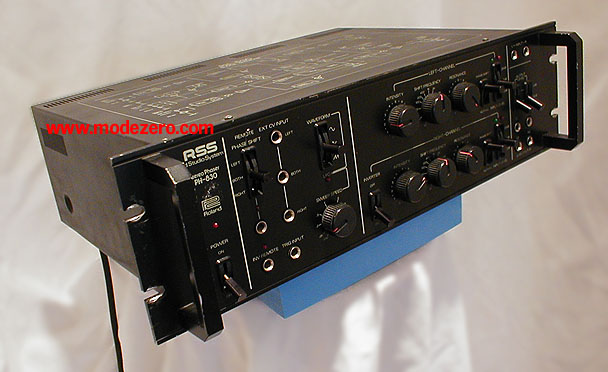
| Roland's PH-830 stereo analog
phase shifter was part of their late 1970s "Roland Studio System" (RSS),
consisting of several hefty rackmount devices, including the classic RV-800 spring reverb
and two very large graphic equalizers. All were equipped with chunky metal rack
handles, a bulletproof front panel, big toggle switches, multiple front and rear panel
inputs and outputs, and excellent specs. In 1979, the list price for the PH-830 was
$795 US. It is not often found on the used market. Although perhaps not as quirky or bizarre as some
phasers, the PH-830 might in some ways be considered an analog "reference
phaser," with a classic phasing tone, very low distortion and silky smooth sweeps,
even at extreme settings. The stereo signal path consists of two eight stage phase
shifters in parallel, with independent inputs, outputs, and CV inputs. Each channel
has controls for intensity (LFO depth), shift frequency (30 Hz - 10 kHz), and resonance
(feedback). If the intensity controls are set to 0, the shift frequency controls
can be used to manually set the phase shift for each channel. |
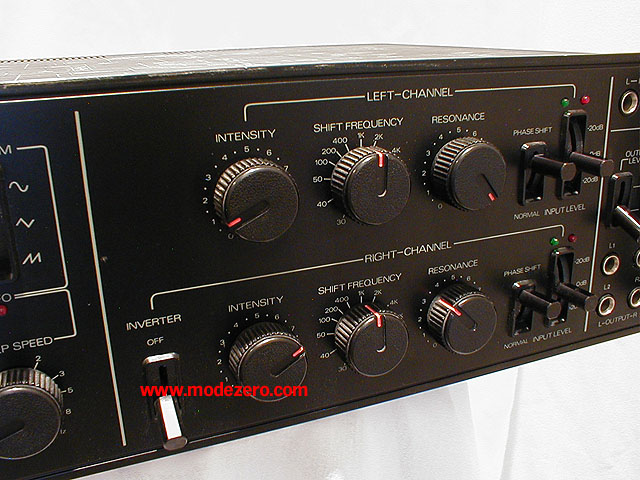
| As the intensity controls are
turned up, both channels are modulated by a single LFO, although an invert switch inverts
the phase of the LFO waveform on the second channel, for panning stereo phasing effects -
it's very tempting to leave it enabled permanently. It would be nice if the PH-830
had independent LFOs for each channel, although it can be driven by external LFOs.
But the PH-830's single LFO is well specified, with a choice of sine, triangle, and
sawtooth (ramp) waveforms, and rates from 1 cycle per minute up to 10 Hz.
There is also an LFO trigger (sync) input, and in general the i/o is what you would expect
of a piece of gear meant to be used with a modular synth. |
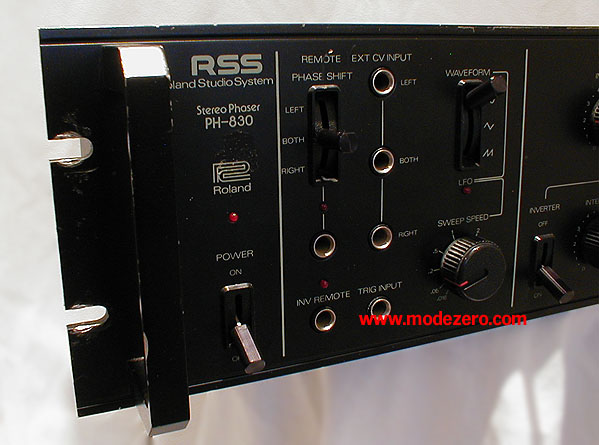
| Internally, the PH-830 is
typical of late 70s / early 80s Roland products: very solid both mechanically and
electronically, with beautiful large circuit boards, beefy components and immaculate
assembly quality. The phaser allpass stages use optocouplers, like the Mu-Tron
Bi-Phase and some other phasers, but the Roland uses additional circuitry to obtain a 1V /
octave control voltage response, while maintaining the low distortion and smooth
modulation response of an opto design. As a result, the LFO sweep sounds natural and
musical at all speeds. Although the Vactrols don't completely tame the edges of the
sawtooth LFO waveform at low rates, at faster LFO speeds the Vactrols' smoothing effect is
just right, enabling asymmetric vibratos and raygun noises. |
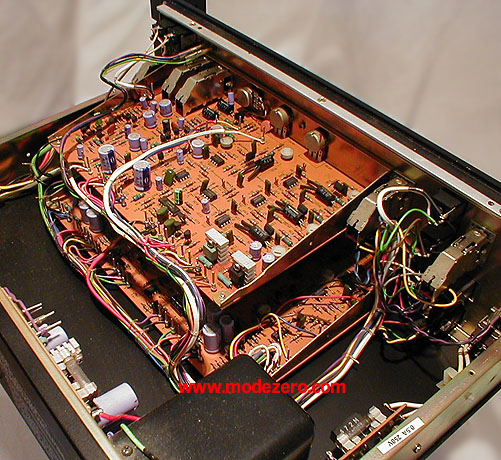
| One characteristic of a great
phaser is that it sounds good at both high and low regeneration (a.k.a. resonance or
feedback) settings, whereas a poor phaser sounds weak unless the regeneration is cranked
up, but then sounds gimmicky. The PH-830 sounds exceptional even at zero resonance,
and its high-regen behavior does have a "Roland sound" - intense but controlled,
tasteful rather than nasty. While perhaps not as over-the-top as some phasers, the
PH-830's transparent yet strong sound allows it to be used in a wider range of
applications. |
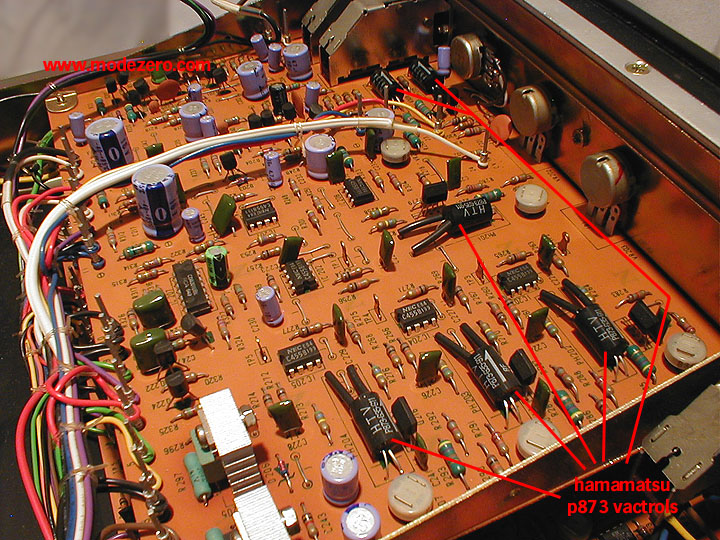
mp3s
| Note: settings given for mp3s
below are identical for both channels except as noted, e.g. "freq = 600/1.4k"
means left freq = 600 Hz, right freq = 1.4 kHz. All mp3s are stereo, 192k. |
pink noise: full-range sweep at maximum
resonance
electric guitar: maximum and minimum
resonance sweeps | pseudo-leslie | asymmetric panning
 |
distortion
guitar, no effect |
 |
distortion
guitar, lfo = slow tri, intensity = 10, freq = 1k, res = 10, invert on |
 |
distortion
guitar, lfo = slow tri, intensity = 10, freq = 1k, res = 0, invert on |
 |
distortion
guitar, lfo = fast tri, intensity = 6, freq = 400, res = 0, invert on |
 |
distortion
guitar, lfo = medium tri, intensity = 6, freq = 700/1.6k, res = max, invert on |
keith leblanc loop 85: phase
auto-pan
oberheim matrix-1000 DCO polysynth: low
and high resonance | asymmetric pseudo-leslie
 |
matrix-1000, no
effect |
 |
matrix-1000,
lfo = medium tri, intensity = 7, freq = 1k, res = 4, invert on |
 |
matrix-1000,
lfo = medium tri, intensity = 6, freq = 1k, res = 9, invert on |
 |
matrix-1000,
lfo = fast tri, intensity = 4.5/5, freq = 500/1.3k, res = 0, invert on |
remat sfx: slow sweeps at half and
maximum resonance
 |
remat
sfx, no effect |
 |
remat sfx, lfo = slow tri, intensity = 6,
freq = 1k, res = 5, invert on |
 |
remat sfx, lfo = slow tri, intensity = 8,
freq = 1k, res = 10, invert off |
yamaha dx7 fm synth: phase vibrato | low
resonance | high resonance
 |
dx7 bells, no
effect |
 |
dx7 bells,
lfo = fast sine, intensity = 6, freq = 2k/1k, res = 0, invert on |
 |
dx7 bells,
lfo = medium sine, intensity = 6, freq = 1k, res = 0, invert on |
 |
dx7 bells,
lfo = medium sine, intensity = 6, freq = 2k, res = 10, invert on |
moog prodigy sawtooth fifths: slow sweeps
at min and max resonance | asymmetric panning
 |
prodigy
saw, no effect |
 |
prodigy
saw, lfo = slow tri, intensity = 10, freq = 1k, res = 0, invert on |
 |
prodigy
saw, lfo = slow tri, intensity = 10, freq = 1k, res = 10, invert on |
 |
prodigy
saw, lfo = medium tri, intensity = 4/7, freq = 2k/1k, res = 5, invert on |
stereo fuzz guitar: standard phase |
squirty-leslie using tri, sin lfo | slow max resonance sweep | extra-squirty slow raygun
 |
stereo
fuzz guitar, no effect |
 |
stereo
fuzz guitar, lfo = medium tri, intensity = 10, freq = 1k, res = 10, invert on |
 |
stereo
fuzz guitar, lfo = medium fast tri, intensity = 7, freq = 1k, res = 0, invert on |
 |
stereo
fuzz guitar, lfo = medium fast sin, intensity = 7, freq = 1k, res = 0, invert on |
 |
stereo
fuzz guitar, lfo = slow tri, intensity = 7, freq = 1k, res = 10, invert on |
 |
stereo
fuzz guitar, lfo = medium fast saw, intensity = 10, freq = 1k, res = 10, invert on |
acoustic guitar: slow high-resonance |
leslie-ish
 |
acoustic guitar,
no effect |
 |
acoustic
guitar, lfo = slow tri, intensity = 5, freq = 1k, res = 10, invert on |
 |
acoustic
guitar, lfo = medium fast tri, intensity = 6, freq = 1k, res = 3, invert on |
korg lambda analog string synthesizer:
medium and slow high-resonance swirl | asymmetric panning
 |
lambda strings,
no effect |
 |
lambda
strings, lfo = medium tri, intensity = 10, freq = 2k, res = 10, invert on |
 |
lambda
strings, lfo = slow tri, intensity = 10, freq = 1k, res = 8, invert on |
 |
lambda
strings, lfo = medium slow tri, intensity = 5/7, freq = 1k/2k, res = 0/4, invert off |
see also: Roland SPH-323
|





